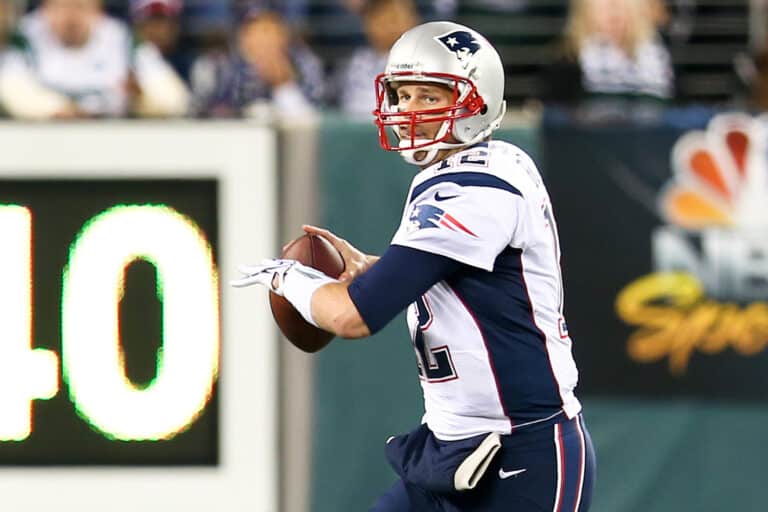How Far Is The NBA 3-Point Line? (All You Need To Know)
Editorial credit: Natursports / Shutterstock.com
Assuming you’ve played basketball and hit a shot beyond the arc. Or you have merely thrown a paper ball into a bin across the room. In that case, you’ll know about the risk-reward of scoring a long-range shot. No matter how casual the game you’re playing, it gets better the further you are from the target – like the 3-point line in the basketball.
In 1979, the NBA 3-point line was 23 feet 9 inches from the arc to the hoop and 22 feet from the corners. From 1994-1997, the NBA briefly adjusted the distance to 22 feet all around to remedy decreasing scores yet reverted to 23 feet 9 inches from the 1997-98 season.
NBA players like Steve Kerr and Dell Curry broke some records with long-distance shots. Yet, when they did not get the expected results, the NBA decided to return to the original distance of the three-point line. Let’s look at the evolution of the 3-point line.
The Evolution Of The NBA 3-Point Rule
Believe it or not, basketball didn’t always have a 3-point line. Before 1979, there were no last-second Hail Mary heaves nor buzzer-beaters to epically win 2-point games since the 3-point rule didn’t exist.
Yet, according to legend, in the early 1930s, a man named Herman Sayger arranged a match between two high school teams from Tiffin, Ohio. He had the idea of having a shot worth three points. Sayger’s rules were as follows:
- A shot made within 15 yards of the hoop would get your team one point.
- A shot made within 25 yards of the hoop would get your team two points.
- A shot made from anywhere beyond 25 yards would get your team three points.
Unfortunately, these rules – however revolutionary – never saw the light of day in an official capacity.
In 1961, Abe Sapperstein and Ray Meyer introduced the 3-point line rule to the ABL (American Basketball League). It was set at a distance of 25 feet. The ABA (American Basketball Association) implemented this rule six years later.
Although the NBA (National Basketball Association) eventually followed suit in the 1979-80 season, it did not replicate the 3-point line of 25 feet. The NBA’s 3-point line measured 23 feet 9 inches from the hoop.
There were three seasons where this distance was changed to a round 22 feet. This distance formed a perfect semi-circle with the hoop as the middle point. From 1994 to 1997, 3-point goals attempted were an average of 16 times per game. This number of attempts was surprising compared to the average of ten times recorded before the line distance changed.
Despite the dramatic increase in 3-point attempts, the average points per game kept declining. So, the NBA reverted to the original 3-point line distance of 23 feet 9 inches.
Arguments Around The 3-point Line Rule
Even before the NBA adopted the 3-point line, there has been a lot of debate regarding its legitimacy. Is the line too close or too far from the hoop? Is the reward of three points too much?
After the first trial in 1932 (remember Herman Sayger?), it was only in 1945 that the NCAA (The National Collegiate Athletic Association) trialed the 3-point rule for a game between college teams from Columbia and Fordham. Many said it drew the game away from “exciting lay-ups.”
As a result, the rule wasn’t seen again for several years.
And even upon its return, not all fans were on board with the 3-point rule. Still, the relevant basketball associations had to stand firm not to create the perception that the rules of basketball could be so quickly challenged. That meant that the rule stayed in place.
The 3-point rule picked up momentum as more people got used to basketball players scoring three points. Eventually, it was made official by the powerhouse league, the NBA, in 1979.
Stats Related To The 3-point Rule
The first season the 3-point line was introduced into the NBA, the average amount of long-distance attempts per game was 2.8, and the 3-point field goals per game was 0.8. This means that only 28% of the shots attempted went in.
Except for the next four seasons, the average attempts per game increased.
The 1987-88 season saw an average of five long-distance shots per game. By 1993-94, this rate increased to 10 attempts. In 1997-98, after the 3-point line was reverted to 23 feet and 9 inches, the attempts per game were 12.7 shots.
Since the late nineties, the average 3-point attempts per game steadily increased. In the latest season of 2021-2022, the rate is a whopping 35.2 attempts in a game. As evidenced by the statistics, teams have increasingly realized the quality of hitting 3-pointers, many of whom have built game plans around it.
Daryl Morey’s Opinion Of The 3-Pointer
Famous for his success as general manager of the Houston Rockets, Daryl Morey built a team around scoring 3-pointers in the 2018-season.
Winning 65 of their 82 regular season games, the Houston Rockets went to the Western Conference finals yet lost to the Golden State Warriors. They lost the game by 9 points and also missed twenty-seven 3-pointers in a row.
Since then, Morey has been heavily outspoken about the value of the 3-pointer. In his opinion, the value of points is too high and should be reduced to two-and-a-half points. He also believes the court should be widened to eliminate the issue of the corners of the 3-point line being closer to the hoop (it is only 22 feet).
Further 3-point Discussions And Statistics
His experience has bolstered Daryl Morey’s opinion. However, there are still a lot of doubts, to the point of surety, that the NBA will not be implementing these appealed changes anytime soon.
One reason these cries are still heard is based on statistics – specifically, the increasing statistics of 3-point attempts. Since 2011-12, there has been a steady increase in the average 3-point attempts per game per season. Unfortunately, as the attempts increase, so do the misses.
Arguments for the 3-point rule to remain is that the NBA must be seen to be consistent and maintain a balance between the pros and cons of the debated rule. Although the 3-point attempts have dramatically increased, every team can practice 3-point shooting. It has kept the court open, inviting diversity and exciting shots from within the arc.

Conclusion
Love it or hate it, the 3-pointer has become a significant part of basketball as time tested its validity. Fixed at 23 feet and 9 inches, the paint on the court is as fixed as the rulebook’s letters. Arguments are still ongoing, but chances are, we’ll continue to see shots from beyond the arc for quite some time.
References
- https://www.active.com/basketball/articles/the-history-of-the-3-pointer
- https://www.basketball-reference.com/leagues/NBA_stats_per_game.html
- https://www.cbssports.com/nba/news/celtics-nets-suns-and-warriors-get-set-to-debut-their-82-act-dramas-on-the-nbas-opening-night/
- https://www.sfchronicle.com/sports/warriors/article/Hoops-history-A-brief-timeline-of-basketball-s-16694105.php







